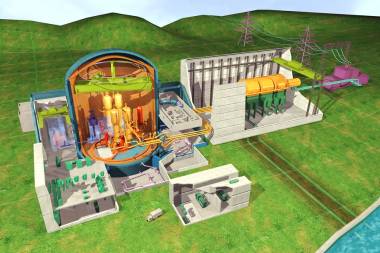EPR system modifications satisfy UK regulator
16 November 2010
The UK nuclear regulator has said that it is satisfied with the efforts made by Areva and Electricité de France (EdF) to address concerns about the control and instrumentation (C&I) systems of its EPR reactor design.
The Health and Safety Executive (HSE), which is conducting the Generic Design Acceptance (GDA) process of the EPR for use in the UK, has written to the two companies to inform them that it has now closed a regulatory issue (RI) relating to the C&I systems.
 |
| A cutaway of the EPR design (Image: Areva) |
The HSE placed an RI on the design of the EPR C&I in April 2009. It said it had four major concerns about the design. Firstly, there were concerns about the "complexity of interconnectivity between the very important Class 1 Safety Systems and lower Safety Class control systems." Secondly, the regulator said there was "a lack of Class 1 equipment including hard-wired and simple technology as a diverse backup to the highly computerised and sophisticated screen based displays and controls in the Main Control Room and Remote Shutdown Station."
In addition, the HSE said that many of the important control systems were engineered to Class 3 standards, whereas they should have been to Class 2 standards. The fourth issue that the HSE had with the design was that the "probabilistic claims being made on the two computer-based safety system platforms meant that the common failure of both was equivalent to being 'incredible' so that the event could effectively be discounted."
However, the HSE has now said that "EdF and Areva have addressed satisfactorily the Nuclear Directorate's concerns by proposing design changes to the C&I for the UK EPR."
EdF and Areva have told the HSE that all networked communications between the control and safety systems will be one-way, from the Class 1 systems to lower Class 2 and 3 systems. With regards to backup systems, the companies will have a Class 1 safety information and control system (SICS) operational in the main control room and a similar panel in the remote shutdown station. The SICS will include simple hard-wired technology and will be fully operational for alarms and displays at all time.
The important control systems will now be engineered to Class 2 standards, the companies said, rather than Class 3. In addition, probabilistic claims on each of the main C&I platforms will have lower limits than in the original design for the UK. Areva and EdF told the HSE that the shortfall in overall reliability of the safety systems will be made up by the introduction of a non-computer-based safety system.
In a letter to Areva and EdF, the regulator said: "While there are some outstanding actions to complete, we are satisfied that you have addressed the majority of the key actions associated with the Regulatory Issue, and those that remain now equate to the status of a Regulatory Observation (RO) within the GDA process."
The HSE noted that an RO, "while still a finding requiring resolution, is at a lower level of importance than an RI and does not necessarily threaten the granting of a Design Acceptance Confirmation."
HSE's Nuclear Directorate added, "We recognize that EdF and Areva have put in a considerable amount of high quality work to get to this position. However, I must remind you that [the Regulatory Observation] is still very challenging and will require a high level of your attention and resource to successfully meet the UK EPR Program."
The HSE said, "The Nuclear Directorate is confident that in the next 6-18 months the submission, by EdF and Areva, of detailed design information should be sufficient to allow closure of those RO actions, and that, in the interim, their extant status should not threaten the meaningful GDA Step 4 conclusion in June 2011."
Philippe Knoche, senior executive vice-president for Areva's reactors and services business group, said: "We welcome the HSE's decision to close the only main issue relating to the EPR reactor." He added, "Thanks to the high quality work of the teams, we have reached another milestone for this new generation I&C system after its architecture was validated in Finland this spring."
The other reactor design progressing through the GDA process is Westinghouse's AP1000. However, the HSE still has an outstanding regulatory issue, raised in February 2010, regarding the company's civil engineering design methodology. The regulator requires Westinghouse to further justify its claims about the robustness of a novel steel-concrete-steel construction method.
Researched and written
by World Nuclear News